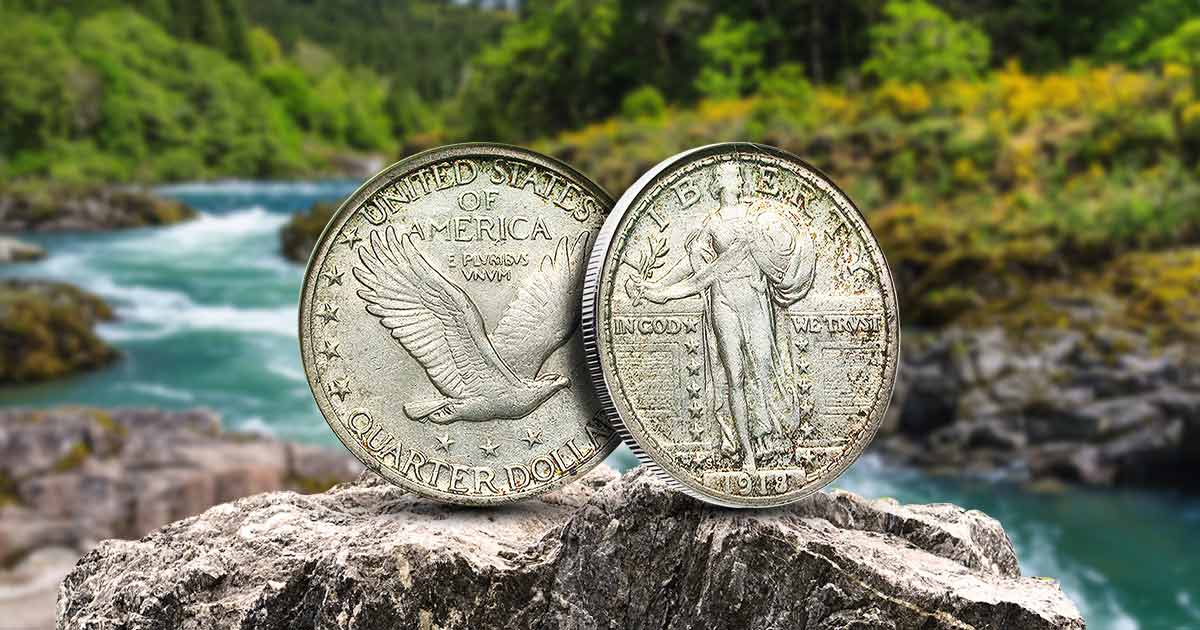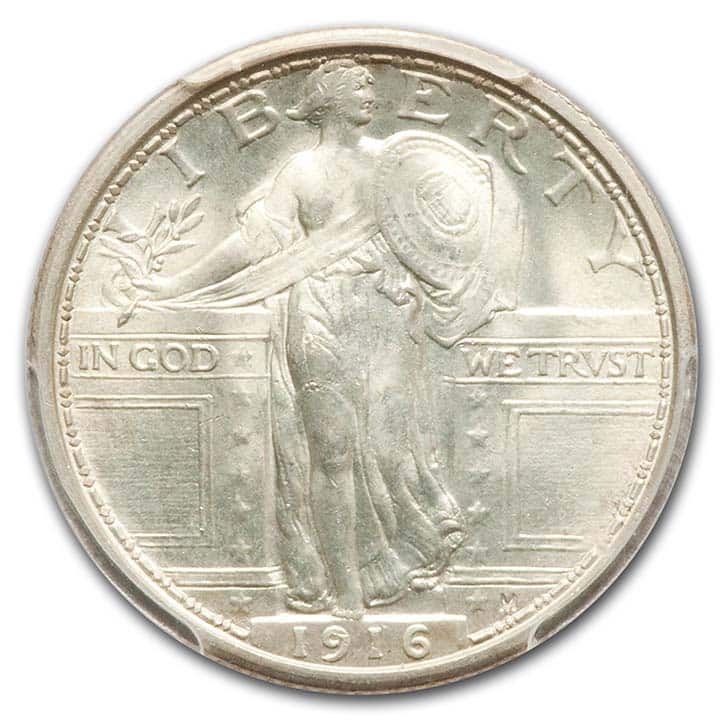
The Standing Liberty Quarter series was designed by Hermon MacNeil. His design was somewhat militaristic, but it was also contentious as Miss Liberty had one exposed bare breast. That was struck in 1916 and again in 1917, but it was redesigned later in 1917 so that Miss Liberty now wore a shirt of chain mail, and the date was recessed so that the quarters stacked better and didn’t wear as quickly.
A special designation for Standing Liberty Quarters is the “Full Head” designation for well-struck coins. According to PCGS:
“PCGS awards the Full Head grading designation to certain Standing Liberty Quarters grading AU50 or better, with an exception as noted below. The FH designation applies to qualifying Standing Liberty Quarters, with different criteria applying to the Type I (1916-1917) issues versus those used when grading Type II (1917-1930) specimens.
- Type I Standing Liberty Quarters earn the FH designation when there is a clear and distinct separation between Miss Liberty’s hair cords and her cap.
- Type II Standing Liberty Quarters receive the Full Head designation when the helmet exhibits three complete and distinct leaves, a complete outline on the bottom of the helmet, and a clear ear hole on Miss Liberty’s head.
There is one notable exception when it comes to applying the Full Head designation on the rare 1918/7-S overdate. On these varieties, PCGS will appoint the FH designation to coins meeting the Type II Full Head standards for coins grading XF40 or better.”
To learn more about this coin series, read our article on the Standing Liberty Quarter’s history.
Key Dates and Varieties
1916 Type 1
As the dies weren’t ready, the Philadelphia Mint struck 1,788,000 Barber quarters but only 52,000 of the new Standing Liberty Quarters. Many of the new coins were hoarded and there weren’t enough to fill the void in circulation.
This coin is so rare, and so much in demand, that a very well-worn Good specimen is at least $5,000.


1916 Standing Liberty Quarter, MS66FH
1918/7-S
The 1918/7-S is the first of the overdates. The normal 1918-S saw over 11 million coins struck, but the 1918-S 8 Over 7 represents a tiny fraction of those coins.
The “7” underneath tends to flatten the top of the “8” and the stem of the “7” is likely visible inside the lower loop of the “8.”

1919-D
The 1919-D Standing Liberty Quarter saw only 1,944,000 coins struck. It is not rare, but it is a better date coin. Often times, these early “D” mint coins are not well struck.
1920-D
Even though the 1920-D has a mintage of 3,586,400, it is still a tough coin to find well-struck and in higher grades.
1921
The 1921 Standing Liberty Quarter struck at the Philadelphia Mint saw only 1,916,000 coins struck. Often times, these coins have lost as much as the bottom half of their date as the digits wear away.
1923-S
The 1923-S had 1,360,000 coins struck at the San Francisco Mint. Much like the Denver mint coins, early San Francisco Mint coins were often weakly struck.
1927-S
This scarce date only had 396,000 examples struck. But between a very low mintage and a weak strike, finding a premium quality coin is quite a task and reasonably expensive.
Standing Liberty Quarter Values
| Date MM | Mintage | Very Fine | Abt Unc | Ch Unc |
| 1916 | 52,000 | $10,000 | $13,500 | $20,000 |
| 1918/7 – S | Included | $6,000 | $17,000 | $27,500 |
| 1919-D | 1,944,000 | $650 | $1,850 | $3,500 |
| 1920-D | 3,586,400 | $300 | $550 | $1,250 |
| 1921 | 1,916,000 | $750 | $1,750 | $2,400 |
| 1923-S | 1,360,000 | $1,500 | $2,750 | $4,250 |
| 1927-S | 396,000 | $650 | $5,500 | $12,000 |
| Common Date | —- | $30 | $195 | $300 |





